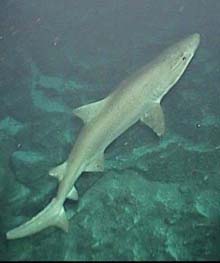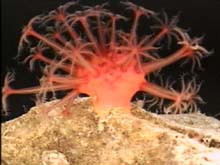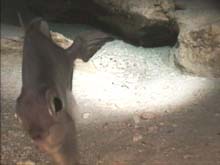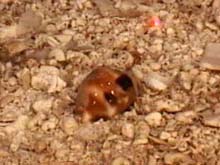Pisces observations
September 19, 2002
Rachel, Shackelford, Data Manager
Hawaii Undersea Research Lab
The Pisces IV launched this morning, in driving rain, for the first occupied submersible dive on the unexplored Northampton Seamounts. Frank Parrish, Chris Kelley, and Terry Kerby were onboard, anxious to see what they could find. Last night's ROV dives helped determine where the dive would occur today and gave the observers an idea of what they might see. The ROV surveyed two freshly mapped areas last night, and the Pisces IV dropped down on the second site, which had the more interesting terrain.
The ROV first was put down on the southern slope of the eastern seamount. The Seabeam map, produced just hours earlier, showed a steep slope that we hoped would consist of hard substrate with good hiding places for fish, and areas where coral could attach. Instead, the slope wasn't nearly as steep as we had imagined, and the bottom was sandy and boring. We still saw several fish, mostly the relatively common (in deep water) Symphosanodon maunaloae, but we also saw some eels and scorpion fish.

Smalltooth sand tiger shark (Odontaspis ferox). This is the first time HURL has video-taped one of these uncommon sharks. His teeth are more jagged than most other types of sharks, which makes him look ferocious even though he is not implicated in attacks on people. Click image for larger view.
After an hour, as we prepared to recover the ROV, a shadow passed across the screen a few times, indicating something big was in between the ROV and its cage. Just as we were lifting off the bottom, a 6- to 8-foot Tiger shark appeared. He swam off after checking out the strange contraption invading his territory.
We repositioned to the southeastern slope of the same seamount and launched the ROV over the side of the ship again. As soon as the ROV reached the bottom, at about 500 m, we were taken aback by big spectacular carbonate structures. There were large troughs and ledges followed by a steep cliff that forced us to lift up the ROV as quickly as possible. This was more like what we were hoping for! Yet we did not see as many fish as we expected.
We did see a few interesting organisms—a red toadstool coral (Anthomastus sp.), a greenish-black rattail fish (Malacocephalus hawaiiensis), a spotted rattail fish (Caelorinchus spilonotus), a bright orange seastar (Pseudarchaster myobrachius), and a shiny silver tinselfish (Grammicolepis branchusculus) that came right up and kissed the camera.
Toward the end of the dive, we saw a rare checkerboard cowrie shell, endemic to Hawai'i. We couldn't tell if it was alive or dead. If it was alive, it was in much deeper water than any other recorded instance for this species.























